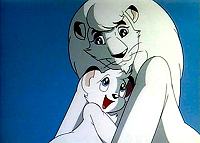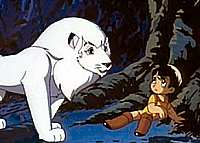
(Japanese title: White King)
A story about spies and scientists. A boy is abandoned in Leo's jungle when his grandfather is kidnapped. It's nice to see Leo get a chance to interact gently with a human boy. There is some nice stylized animation during Leo and Lea's trek through the desert.
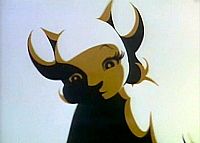
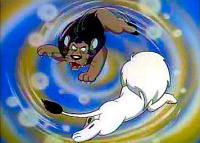
(Japanese title: Confrontation in the Grasslands)
Leo gets the animals to report the dangers they encounter so that others may learn to avoid them. A bit of tension as Leo meets an attractive female lion, but nothing comes of it.
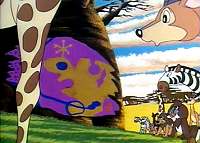

(Japanese title: Zamba of the Blue Mane)
Leo learns the reason a blue lion is so antagonistic.
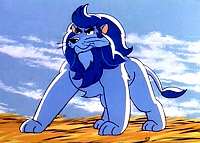
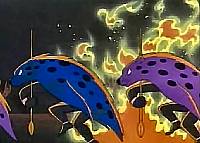
(Japanese title: The Pygmys' Death Dance)
A hunt for Leo results in him being temporarily blinded.
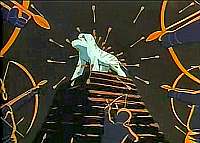
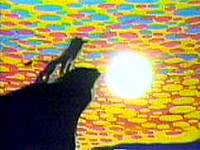
(Japanese title: Rune's Adventurous Journey)
Rune and Rukio are born to Leo and Lea. The best episode so far, as Leo decides that Rune needs some help to be up to the life that awaits him. The opening scenes of this episode (which are cut out of most home video versions) would likely not be done today because of the way they depict the tedium of waiting for the cubs to be born. Given the American point of view of TV, it's no wonder that part is often cut out.
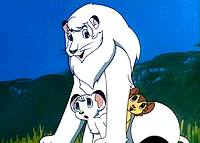
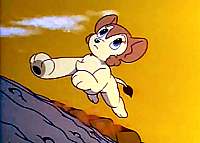
(Japanese title: Donbe, the Huge Beast)
A peaceful band of gorillas, dependent on a giant for their safety, seek a new home. Rukio gets to shine in this episode, as she befriends a fearsome, and fearful, gorilla. If only there could have been more stories about her...
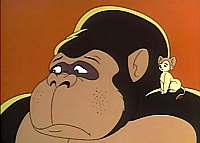

Two people, a father and son, are the last survivors of their tribe. Because they possess a golden bow, they are pursued throughout Africa. Watch Rune as he befriends the human boy.


(Japanese title: The Secret of the Moonlight Stone)
The powerful moonstones are the quest in this spoof of James Bond movies. There's more comedy than usual in this episode. Watch for some Terry-Gilliam-esque animation near the end.

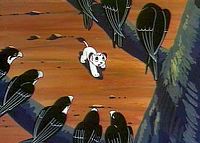
(Japanese title: Bird of Terror)
A threatening flock of falcons invades Leo's jungle. Another surprising bit of stylized animation as Leo rescues Rune.
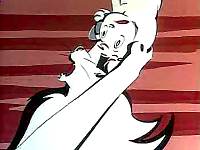
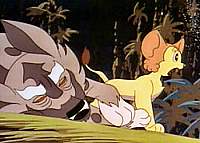
(Japanese title: Lycons Do Not Cry)
An enemy of Leo's befriends Rune and Rukio. A pretty good episode, since it focuses largely on the two cubs, and reveals some complexity to the title character.


(Japanese title: Panja Goes to Town)
Rune thinks he is protecting it when he places Panja's hide in a tree. It is spotted by men in a helicopter who take it to a city. The white lion skin is swapped about through lies and corruption while Leo and Rune try to get it back. A good story featuring lots of interesting situations for the two male lions.
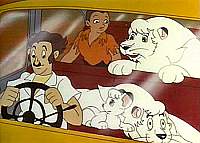
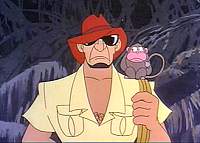
(Japanese title: The Poacher's Woods)
One of the strongest episodes of the entire Leo series, dealing powerfully with the harm done by poaching. Seeing Rune caught in a wire snare is heartbreaking.
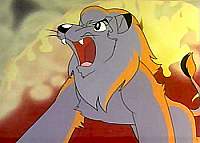
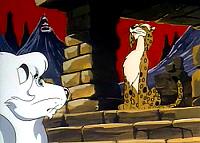
Leo becomes involved in a bizarre revenge match between a blind man and a leopard. This episode is based on a manga story, but not part of the original Jugle Emperor manga. This story was first published as one of the "Leo Chan" series around the time the Kimba series first aired. Leo was a cub in the manga story. Click here to compare the manga with the TV version.

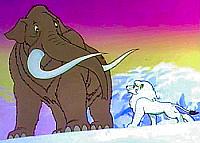
(Japanese title: The Glacier that Roared)
The mysterious mammoth reveals that other prehistoric creatures still exist as well. Good adventure, and a chance to see Rune in action again.
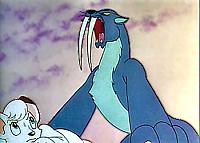
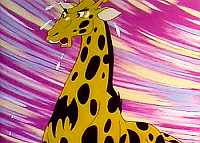
(Japanese title: The Lonesome Tomb)
A giraffe has strange markings which make it an outcast from its herd, and desired by hunters. Here Rune shows more of the spirit of Kimba than Leo does.
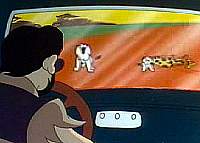

(Japanese title: The Black Monster in the Jungle)
The trauma of a plane crash causes a woman's pet leopard to go wild.

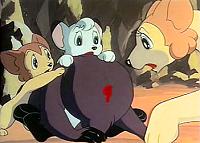
Leo reluctantly aids Totto (Cassius) the panther who, at the first opportunity, tries to kill Rune and Rukio. Leo's rage is so great that he inadvertently hurts Mandy (Dan'l). This episode is almost completely inexplicable. Once you get past Leo's outburst--which I do fully understand, by the way--his behavior is completely out of character and the following events are silly.

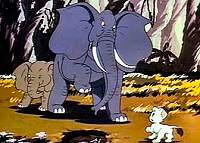
(Japanese title: Locomotive Battle)
The obnoxious elephant, Bizo, must cooperate with Rune or both of them will die! A good feature for Rune.
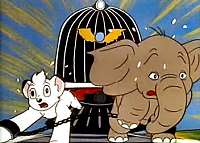
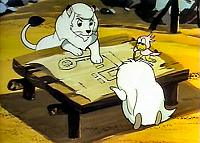
(Japanese title: The Stone Fortress)
Rune gets the idea to build a stone castle as protection against disasters like fire. The visual style of this episode baffles me. This one must have been drawn by an entirely different team of artists.

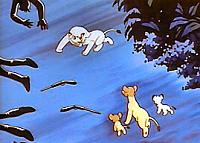
The surrounding area is engulfed in an advancing flood. Leo finds that the cause of the flood is a new dam. This entire story baffles me.
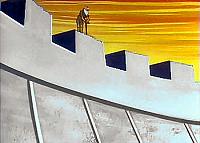
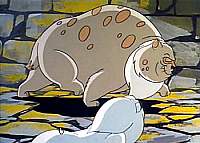
(Japanese title: The One Who Sold the Jungle)
The hyenas, under an enormous Godfather-like leader, trap Leo into helping with a deadly plan. There's a surprising amount of blood in this one.
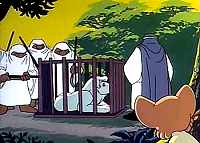
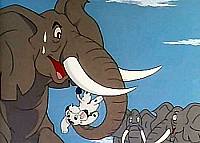
(Japanese title: The Elephants' Graveyard)
Thousands of hungry and thirsty elephants approach Leo's jungle. The resident herd of elephants does not want to allow them to live there. Rune really strives to do the right thing in this one.
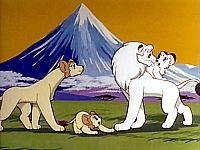
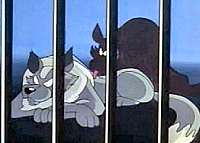
A plane transporting Russian wolves crashes in the jungle. The wolves take Rukio prisoner as they try to find a way to survive.
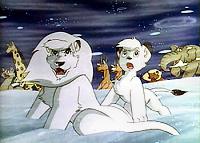
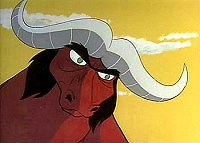
Rune and Rukio help a blind buffalo. Both cubs show increasing independence in this episode.
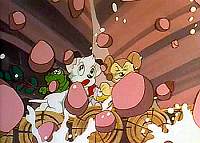
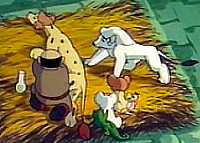
(Japanese title: The Sun Will Rise Again Over the Royal Castle)
A spotted fever plague sweeps through the jungle, affecting most of the animals. This one shares its story line with part of the original manga, and with a major portion of the 1997 Jungle Emperor Leo movie. Here, the outcome is changed. I've found this episode good to show to people who have been traumatized by the movie version.
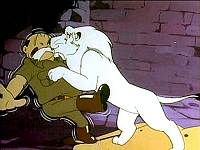

Leo accompanies an expedition to Mt. Moon to search for the moonlight stones, which can solve the world's energy shortage. Rune stows away with the expedition. Again, this episode shares its story line with part of the original manga, and with the end of the 1997 Jungle Emperor Leo movie. Here, the outcome is changed, and Rune comes to emotional maturity. Again, this episode can serve as an antidote to the movie version.
